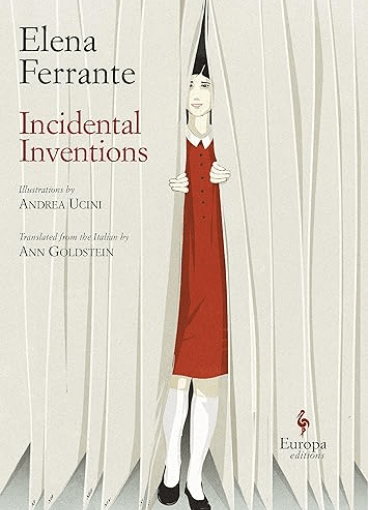This book is a collection of articles which appeared in the Guardian newspaper from January 2018 for one year. Ferrante had never written like this before and so asked the editors to suggest headings – I suppose when left to choose what to write about there was so much it appeared overwhelming.
Writing this column has instead made me tense every Saturday. It has been the permanent exposure of fragments of myself: I couldn’t free myself from one before I had to think about the next.
p114
The book is illustrated by Andrea Ucini very beautifully, with the front cover showing someone, presumably Ferrante, trapped between the pages of a book, peering out. Is the person in the image concealing or revealing. I am not quite sure which this book does.
I find her writing very formal, almost rigid although I am not quite sure why. Is it the grammar or the translation? Is there a written form of Italian, like French, that we don’t use orally? Whatever, it doesn’t appeal to me. I find it a bit staccato. What I did like though, were a couple of her articles based on exclamation marks – don’t use them, and ellipses.
At least in writing we should avoid acting like the fanatical leaders who threaten, bargain, make deals and then exult when they win, fortifying their speeches with the profile of a nuclear missile at the end of every wretched sentence.
p34
I blame social media myself! And on ellipses . . .
They are pleasing. They’re like stepping stones, the sort that stick out of the water and are a risky pleasure to jump on when you want to cross a stream without getting wet.
p59
I love the image of them as stepping stones to get you across the void.
Then there is ‘The Female Version’, or what I call ‘What if . . .’ stories where Ferrante takes a story she likes with a male lead character and tries to retell it with the protaganist as a female. In the article she has been trying to make the story Wakefield by Nathaniel Hawthorne work but can’t. A woman just wouldn’t do what Wakefield does. It is an interesting idea to play around with, though.
And finally, there is the article about linguistic nationality. Our language forms and shapes our thinking and give us our writing identity but thanks to translators . . .
. . . Italianness travels through the world, enriching it, and the world, with its many languages, passes through Italianness and modifies it. Translators transport nations into other nations . . . it draws us out of the well in which, entirely by chance, we are born.
p24
The illustration for this article is a typewriter in front of an open window with the paper forming a road that disappears over the hills, into the distance.
In the article ‘This is Me’, Ferrante explains that she doesn’t like photos of herself yet displayed one from when she was seventeen and didn’t look like herself. This is a clear case of where she won’t reveal herself although the writings in the book do go someway to revealing herself as a writer. As she says, this ‘me’ is visible ‘for only a few seconds and then we are swallowed up, to return to our everyday aspect.’ The illustration frames with first finger and thumb on each hand a female figure standing in the distance with her back to us. She is there but the detail is not clear. I think this framing of fragments is an interesting literary device used throughout the book and mirrors Ferrante’s revealing and concealing of herself to us.
Which leads me to the title. Is Ferrante inventing herself here? Does it refer to the fragments of herself as seen in the book? Is she inventing herself as a minor accompaniament to the writing about a topic? I’m not really sure. As Ferrante says in ‘The False and the True’
I can’t trace a line of separation between fiction and nonfiction.
p21
This is definitely a book for a book club, especially one that has read My Brilliant Friend before.
